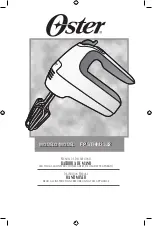
13
TROUBLESHOOTING
If the stand mixer shuts off and “ERROR” appear and flash on the dial, the unit may have
overheated . Your stand mixer , has an overload protection device; it will shut down to
protect the motor.
Solution: In the unlikely event that this happens:
•
Turn off and unplug the unit.
•
Reduce the load by removing some of the ingredients, and allow the mixer to rest for
a few minutes.
•
Plug in and reset the speed. If the stand mixer does not start when you activate a
program, allow the unit to rest for additional time.
•
If the stand mixer does not start and “ERROR” still appears on the dial even when the
unit has cool down, please contact our consumer service for help.
TIPS AND HINTS
•
Before preheating your oven, adjust racks to accommodate your baking task. Most
recipes use the middle rack; pies bake best in the lower third of the oven.
•
Carefully follow each mixing step in a recipe. Take care not to over- or under-mix.
•
Don’t crowd the oven, and avoid opening the oven door during baking – use the oven
light to help you watch. With certain recipes, particularly when baking more than one
tray of biscuits at a time, rotate halfway through baking.
•
Proper measurements are very important when baking. To measure flour correctly, stir
the flour first, then spoon into the measuring cup. Level off the top with the blunt side
of a knife blade. Do not press or compact flour. It is also very important not to measure
directly from the bag – while the flour is pre-sifted, it has been pressed/compacted to
fit into the bag. Baked goods made from unstirred flour are likely to be heavy and dry
because too much flour is used.
•
For most baking recipes, refrigerated items like butter, milk and eggs incorporate better
when they are at room temperature.
•
Remove butter from the refrigerator and cut into 1cm pieces to help it come to room
temperature faster while you measure out the remaining ingredients. Do not warm
butter in the microwave; this can change the structure of the butter if it melts and give
the finished product a different texture.
•
To separate eggs for use in any recipe, break them one at a time into a small bowl.
Gently remove the yolks, then transfer the whites to a spotlessly clean glass or
stainless bowl. If a yolk breaks into a white, use that egg for another recipe. Just a
drop of egg yolk in the white prevents the white from whipping properly.
•
Scraping the entire bowl – sides, bottom and paddle over the course of mixing and
adding new ingredients – ensures even incorporation of ingredients and overall best
results. The more you scrape the bowl, the better.
•
For whipping egg whites, both the mixing bowl and chef’s whisk must be spotlessly
clean and dry. Any trace of fat/oil will prevent the egg whites from whipping properly.
•
To check the freshness of eggs, place them in a bowl of warm water – if they float, they
are not fresh. This is most important when using for whipping egg whites. The fresher
the eggs, the more stable the foam.











































